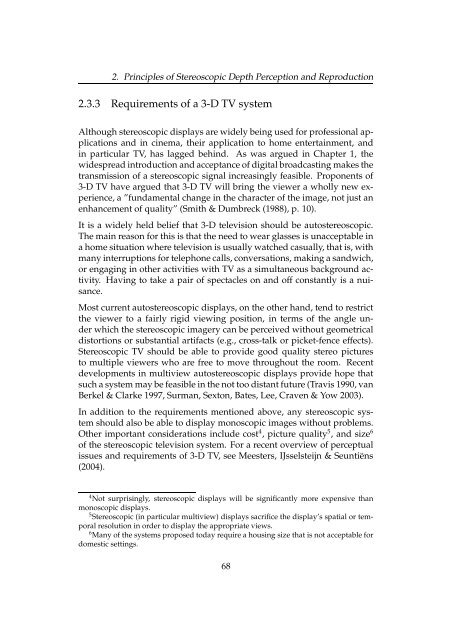Chapter 2 Principles of Stereoscopic Depth Perception and ...
Chapter 2 Principles of Stereoscopic Depth Perception and ...
Chapter 2 Principles of Stereoscopic Depth Perception and ...
You also want an ePaper? Increase the reach of your titles
YUMPU automatically turns print PDFs into web optimized ePapers that Google loves.
2. <strong>Principles</strong> <strong>of</strong> <strong>Stereoscopic</strong> <strong>Depth</strong> <strong>Perception</strong> <strong>and</strong> Reproduction<br />
2.3.3 Requirements <strong>of</strong> a 3-D TV system<br />
Although stereoscopic displays are widely being used for pr<strong>of</strong>essional applications<br />
<strong>and</strong> in cinema, their application to home entertainment, <strong>and</strong><br />
in particular TV, has lagged behind. As was argued in <strong>Chapter</strong> 1, the<br />
widespread introduction <strong>and</strong> acceptance <strong>of</strong> digital broadcasting makes the<br />
transmission <strong>of</strong> a stereoscopic signal increasingly feasible. Proponents <strong>of</strong><br />
3-D TV have argued that 3-D TV will bring the viewer a wholly new experience,<br />
a ”fundamental change in the character <strong>of</strong> the image, not just an<br />
enhancement <strong>of</strong> quality” (Smith & Dumbreck (1988), p. 10).<br />
It is a widely held belief that 3-D television should be autostereoscopic.<br />
The main reason for this is that the need to wear glasses is unacceptable in<br />
a home situation where television is usually watched casually, that is, with<br />
many interruptions for telephone calls, conversations, making a s<strong>and</strong>wich,<br />
or engaging in other activities with TV as a simultaneous background activity.<br />
Having to take a pair <strong>of</strong> spectacles on <strong>and</strong> <strong>of</strong>f constantly is a nuisance.<br />
Most current autostereoscopic displays, on the other h<strong>and</strong>, tend to restrict<br />
the viewer to a fairly rigid viewing position, in terms <strong>of</strong> the angle under<br />
which the stereoscopic imagery can be perceived without geometrical<br />
distortions or substantial artifacts (e.g., cross-talk or picket-fence effects).<br />
<strong>Stereoscopic</strong> TV should be able to provide good quality stereo pictures<br />
to multiple viewers who are free to move throughout the room. Recent<br />
developments in multiview autostereoscopic displays provide hope that<br />
such a system may be feasible in the not too distant future (Travis 1990, van<br />
Berkel & Clarke 1997, Surman, Sexton, Bates, Lee, Craven & Yow 2003).<br />
In addition to the requirements mentioned above, any stereoscopic system<br />
should also be able to display monoscopic images without problems.<br />
Other important considerations include cost 4 , picture quality 5 , <strong>and</strong> size 6<br />
<strong>of</strong> the stereoscopic television system. For a recent overview <strong>of</strong> perceptual<br />
issues <strong>and</strong> requirements <strong>of</strong> 3-D TV, see Meesters, IJsselsteijn & Seuntiëns<br />
(2004).<br />
4 Not surprisingly, stereoscopic displays will be significantly more expensive than<br />
monoscopic displays.<br />
5 <strong>Stereoscopic</strong> (in particular multiview) displays sacrifice the display’s spatial or temporal<br />
resolution in order to display the appropriate views.<br />
6 Many <strong>of</strong> the systems proposed today require a housing size that is not acceptable for<br />
domestic settings.<br />
68


